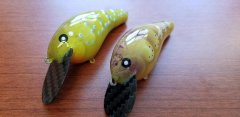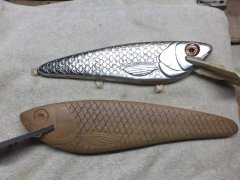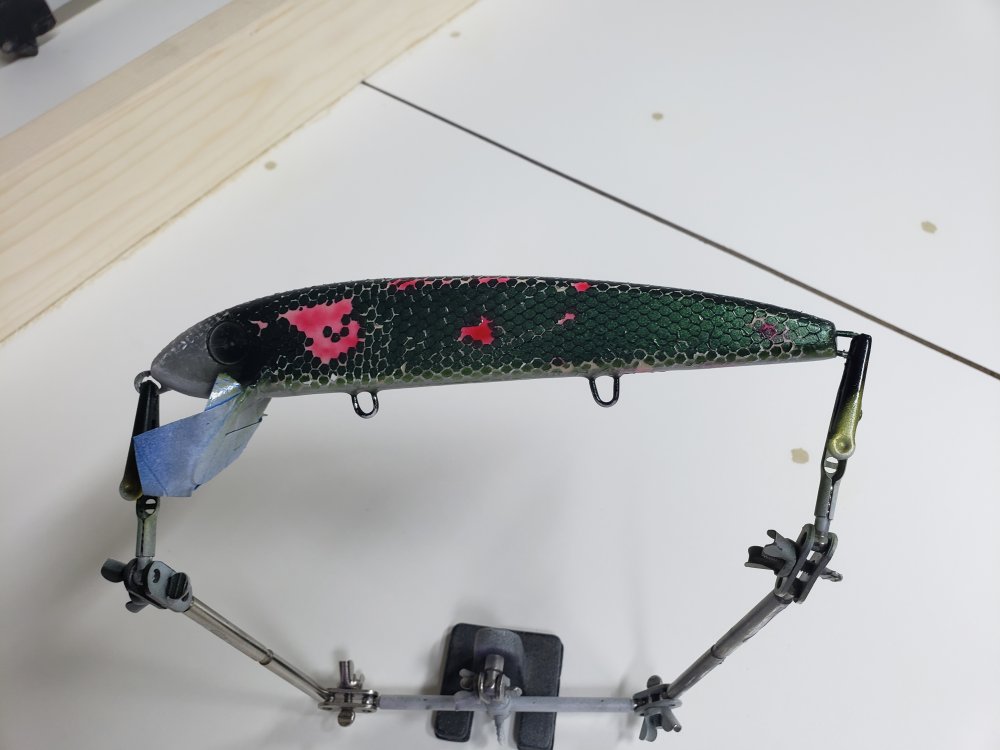
exx1976
TU Member-
Posts
212 -
Joined
-
Last visited
-
Days Won
7
exx1976 last won the day on April 9 2021
exx1976 had the most liked content!
Recent Profile Visitors
The recent visitors block is disabled and is not being shown to other users.
exx1976's Achievements
-
-
-
Do you do foiled lures? If so, please step inside...
exx1976 replied to exx1976's topic in Hard Baits
I'll have to go look for his. I just shot the black back up against the scales, and then shot clear over it. It looks sharp already!! Also did another one in just plain full foil. Shot clear over that as well to help the Epoxy adhere. On that one, I left a strip down the belly and a strip down the back without foil. That'll level off with epoxy, and there will be solid color paint there. I figured it was easier than trying to make a clean joint. We'll see how they turn out. -
Do you do foiled lures? If so, please step inside...
exx1976 replied to exx1976's topic in Hard Baits
Understood. I always make that same disclaimer as well. But at my learning stage with doing foils, it's still helpful to hear other methods - whether they are the "best" or not. As far as I'm concerned, "best" is subjective anyway. Depends on what your goals are. Some guys put quality first, some put speed first, others put cost effectiveness first. Judging my your process and your results, you are putting quality first - which is exactly what I'm doing, so I think I'm going to try that route. Thank you much for your insights, and I'll be sure to come back and let you know how it turns out!! -
Do you do foiled lures? If so, please step inside...
exx1976 replied to exx1976's topic in Hard Baits
Wait, I'm confused - Are you doing polycrylic then paint then epoxy, or are you doing polycrylic then epoxy then paint then epoxy? Looking to finish the head on this lure today, then do another that's just one big piece of foil, and then get all of them either basecoat or paint by tonight, depending on how I do this. Thanks! -
Do you do foiled lures? If so, please step inside...
exx1976 replied to exx1976's topic in Hard Baits
How long do you let the epoxy cure between the base coat, paint, & top coat? -
Do you do foiled lures? If so, please step inside...
exx1976 replied to exx1976's topic in Hard Baits
That looks great! Thank you for the quick reply, but I guess I was more interested in how you applied the epoxy on top of the scales, and then did you scuff it before paint, etc, stuff like that. -
Do you do foiled lures? If so, please step inside...
exx1976 replied to exx1976's topic in Hard Baits
That is EXACTLY what I'm going for. Looks like you even used the same method that I did. I'm more concerned with the visual effect of the 3D scales than I am the touch - I expect the lure to be flat, like any other lure, so as not to create undue turbulence in the water. Can you walk me through exactly how you did that one? I've got my scale application completed, just need to foil the head/gillplate and then I'm ready to move on. I want the finished product to be exactly as I see yours there (different colors, but same basic idea. I'm planning to leave the belly "naked", and then do either a bass or maybe trout pattern on it. Or maybe walleye, or even cisco. Haven't QUITE nailed that part down just yet. LOL) Thanks!! -
Do you do foiled lures? If so, please step inside...
exx1976 replied to exx1976's topic in Hard Baits
Can you elaborate on why you do it that way? My thought is that epoxy before paint would flatten the 3D effect of the scales? And I'm sure you have to scuff the epoxy coat over the scales before paint and topcoat, so what kind of effect does that have on the transparency of the paint underneath and the scales showing through that seal coat? I'd hate to do all this work and have it hidden or have only the belly be visible... -
I, too, drill holes through my lips so there is a mechanical bond through the lip itself. My lips are epoxied in when I fill the slot from running the thru-wire. I fill it with epoxy and West systems 404. I do the initial epoxy curing at a somewhat cool temperature, so the epoxy sets up more slowly. This allows me to check when it reaches sort of a "clay-like" consistency, which makes it very easy to trim excess epoxy using an exacto knife. The blanks are then moved to a warmer area, where they very quickly finish curing rock-hard. I'm not sure that I'd recommend *any* of my processes to anyone, though. They are all rather time consuming, and likely even somewhat convoluted - but I'm pleased with the results. I'm sure with more experience I will continue to refine them to reduce the time investment.
-
Depending on the type of resin used, he could also be looking at amine blush. This is common with many types of marine-grade resins used in ship building/repair. Since I don't recall that he specified what resin he was using, I wouldn't rule this out. Some of the West Systems stuff will do this - however, it's not a big deal. It comes off with soap and water. Google "amine blush" for more info.
-
I've also been thinking about using the candy colors on some baits, but with everything else going on in life right now, I'm thinking that will be a next winter project. I have watched a number of YouTube videos about the candy colors, and if memory serves, they do recommend specific base colors under the candies to get the effect that they advertise. In at least one of the videos, they shot two different base colors on two different pieces to compare the outcomes. It appears to be a fairly straightforward process in terms of actually shooting the color, though (again, if memory serves) they recommend many, many thin layers to achieve the effect. Fewer, thicker layers of paint will not do near as well. The results certainly are sharp, and I think that a candy green or candy purple or even a candle apple red musky lure would certainly catch fishermen, if not fish. Please do keep us posted on your findings, I'll be watching this topic closely. Best of luck, I'm sure you'll do fine!
-
No posts since Thursday! What's everyone working on?
exx1976 replied to eastman03's topic in Hard Baits
House hunting, writing offers, and hand-laying foil scales on a blank. Holy time consuming, batman! -
So... Before I get right to it, a wee bit of an update: I've been met with encouraging success in selling my lures. So far I've done two runs of lures (10 in total), and of those, 7 have sold. In fairly short order, I might add. Some within minutes of listing online, and several were custom pattern requests that turned out absolutely gorgeous. One was so beautiful I was sad to see it go. Then life has gotten in the way (house hunting, demands of my day job, etc), so I haven't sold anything in a couple weeks. But, I've still been working some behind the scenes. I have a batch of 10 that's ready for their seal coat epoxy, which leads me to my question: One of the lures, I have spent HOURS upon HOURS of time, very carefully hand-laying foil scales onto. To cover ~6" of an 8" lure, moving approximately 1/8" at a time, including cutting out all the foil, it's quite a time-consuming endeavor. I'm not sure that I'd do it again, but I suppose it depends on what it fetches when I list it online for auction. In any event, my question is: When you guys foil a lure (this is my first one), do you paint directly on the foil, or do you do an epoxy coat first, then paint on top of the epoxy, then topcoat? I can't decide which route I want to go with it, so I'm looking for advice from more experienced builders, and pros/cons of each option (or if there's some other option I've not thought of?). Given the amount of time I already have in this lure, I'd hate to "wing it" and screw up what is shaping up to be quite the work of art. Thanks!
-






